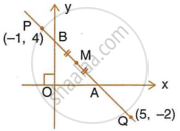Advertisements
Advertisements
प्रश्न
A line is of length 10 units and one end is at the point (2, – 3). If the abscissa of the other end be 10, prove that its ordinate must be 3 or – 9.
उत्तर
Let AB be the line of length 10 units then A (10, y)
A 10 units B
(2, -3) (10, y)
⇒ `sqrt((2 - 10)^2 + (-3 -y)^2)` = 100
Squaring both sides
⇒ 64 + 9 + y2 + 6y = 100
⇒ y2 + 6y + 73 - 100 = 0
⇒ y2 + 6y - 27 = 0
⇒ y2 + 9y - 3y - 27 = 0
⇒ y(y + 9) -3(y + 9) = 0
⇒ (y + 9)(y - 3) = 0
⇒ y = -9 or y = 3
Ordinate is 3 or -9.
Hence proved.
APPEARS IN
संबंधित प्रश्न
Three vertices of parallelogram ABCD taken in order are A(3, 6), B(5, 10) and C(3, 2)
1) the coordinate of the fourth vertex D
2) length of diagonal BD
3) equation of the side AD of the parallelogram ABCD
Using a graph paper, plot the points A(6, 4) and B(0, 4).
- Reflect A and B in the origin to get the images A' and B'.
- Write the co-ordinates of A' and B'.
- State the geometrical name for the figure ABA'B'.
- Find its perimeter.
A straight line passes through the points P(–1, 4) and Q(5, –2). It intersects the co-ordinate axes at points A and B. M is the mid-point of the segment AB. Find:

- The equation of the line.
- The co-ordinates of A and B.
- The co-ordinates of M.
(1, 5) and (–3, –1) are the co-ordinates of vertices A and C respectively of rhombus ABCD. Find the equations of the diagonals AC and BD.
Show that A(3, 2), B(6, −2) and C(2, −5) can be the vertices of a square.
- Find the co-ordinates of its fourth vertex D, if ABCD is a square.
- Without using the co-ordinates of vertex D, find the equation of side AD of the square and also the equation of diagonal BD.
O(0, 0), A(3, 5) and B(−5, −3) are the vertices of triangle OAB. Find the equation of median of triangle OAB through vertex O.
O(0, 0), A(3, 5) and B(−5, −3) are the vertices of triangle OAB. Find the equation of altitude of triangle OAB through vertex B.
A line AB meets the x-axis at point A and y-axis at point B. The point P(−4, −2) divides the line segment AB internally such that AP : PB = 1 : 2. Find:
- the co-ordinates of A and B.
- equation of line through P and perpendicular to AB.
Use a graph sheet for this question.
Take 1 cm = 1 unit along both x and y axis.
(i) Plot the following points:
A(0,5), B(3,0), C(1,0) and D(1,–5)
(ii) Reflect the points B, C and D on the y axis and name them as B',C'andD' respectively.
(iii) Write down the coordinates of B',C 'and D'
(iv) Join the point A, B, C, D, D ', C ', B', A in order and give a name to the closed figure ABCDD'C'B
Use a graph sheet for this question, take 2 cm = 1 unit along both x and y-axis:
- Plot the points A (3, 2) and B (5, 0). Reflect point A on the y-axis to A΄. Write co-ordinates of A΄.
- Reflect point B on the line AA΄ to B΄. Write the co-ordinates of B΄.
- Name the closed figure A’B’AB.
